Why Do Playing Cards Have Aces, Jacks, Queens and Kings?
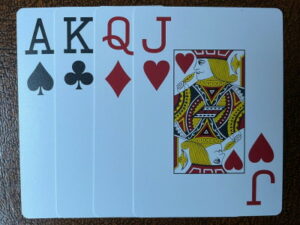 There are many games available to play that utilise cards. From exciting variations of blackjack through to games of poker, they all need them. And since several centuries ago, playing cards have been in existence.
There are many games available to play that utilise cards. From exciting variations of blackjack through to games of poker, they all need them. And since several centuries ago, playing cards have been in existence.
The cards themselves have changed throughout the years. Different nations around Europe and indeed the world have constructed their own versions. Yet for many of these, the values of the cards remain the same. They always tend to run from the lowest of the ace and up through to the Jack, Queen and King.
Why do we have these cards within a deck, though? Isn’t it more logical to start with the number 1, rather than an ace? What is the reason for royalty and such appearing on playing cards, too? Here, we’re going to take a look at these cards and find out where they came from. Plus, we want to know why each suit only has 13 cards. What was the reason for that number and did anyone ever try to create bigger decks? Join us for a closer look at the playing cards we use today.
The Ace Card
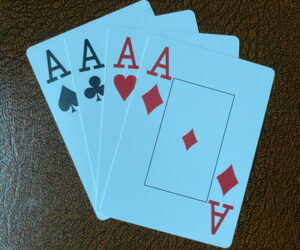 The ace represents the lowest playing card in a deck, featuring a single pip. This is usually represented by the heart, spade, club or diamond in the middle of the card. Sometimes (especially in the case of the ace of spades), the design is large and decorative. This embellishment of the ace of spades came about during the rule of King James VI of Scotland. He required an insignia of the printing house on the ace of spades.
The ace represents the lowest playing card in a deck, featuring a single pip. This is usually represented by the heart, spade, club or diamond in the middle of the card. Sometimes (especially in the case of the ace of spades), the design is large and decorative. This embellishment of the ace of spades came about during the rule of King James VI of Scotland. He required an insignia of the printing house on the ace of spades.
This was necessary for both identification of the printing house and verification of stamp tax payment. That particular necessity came to an end in 1960, but the card design has remained. It’s also the case that the embellishments come on ace cards in other countries. France decorates the clubs card, Russia the diamonds, and Genoa decorates the hearts.
If you look to the Old French language, this is where the word ‘ace’ comes from. It derives from the word as, from Latin, meaning ‘a unit’. This was the name given to a small Roman coin, and its original usage was for the side of a die with one pip. Because it was the lowest roll of the die, tradition dictates that it meant ‘bad luck’ in Middle English. Today, the ace can often be the highest playing card as well, so its meaning has changed.
In the beginning, the ace had a low value attributed to it. This still remains true in many popular European games today. As it happens, many European decks of cards do not use the ‘ace’ or ‘A’ index. Instead, they utilise the standard number of ‘1’ on them. Some believe that the modern idea of “ace high” came about in stages. Before card games came to Europe, they featured suits with a reverse ranking. This is visible in the Chinese card game of Madiao. No court cards operate as part of the game. The deck inverted the suit of coins, so the 1 was the highest in the suit. The idea of this, and from other card games, carried over to European games. That includes games such as Ombre, Maw and Trionfi.
Then, during the 15th and 16th centuries, suit rankings were becoming progressive. The ace comes between the 10 and J in the game of Triomphe, for example. It is the game of Trappola from Venice that operates as the earliest known one to rank the ace high. Since that time, it has stuck around as both a high and low card in many games.
The King Card
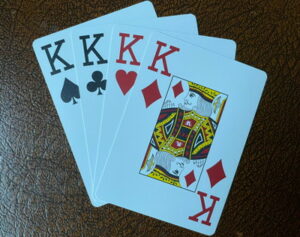 The king, as everyone knows, is the card that features an image of a king on it. It is usually always the highest ranked face card of the three in a deck. Some games do put the ace higher than the king, though. It is the king that is the oldest and most well-known of the court cards. History dictates that it is likely to have originated in Persian Ganjifeh. These playing cards depicted the kings as sitting on thrones. They also outranked the viceroy cards in such decks.
The king, as everyone knows, is the card that features an image of a king on it. It is usually always the highest ranked face card of the three in a deck. Some games do put the ace higher than the king, though. It is the king that is the oldest and most well-known of the court cards. History dictates that it is likely to have originated in Persian Ganjifeh. These playing cards depicted the kings as sitting on thrones. They also outranked the viceroy cards in such decks.
Once playing cards arrived in Europe via the Maluks and Moors, the king came along. There is a well-preserved deck of Mamluk cards known as the Topkapı pack, which did not have human figures. Instead, they listed the king in written text, likely due to religious restrictions.
Seated kings became common throughout Europe to begin with. Yet in the 15th century, Spanish card manufacturers began producing standing kings. The French used the same Spanish cards before developing their own regional deck. With this being the case, they reused a lot of the Spanish card designs in their own suit-system.
The English imported cards from Rouen until the 17th century. At this point, a ban on foreign card imports became law. Yet English manufacturers did not use high-quality materials for their decks. This resulted in the kind of hearts sometimes going by the name of the “suicide king”. Why? Because he seems to be sticking his sword into his own head. The bad quality of the prints in England saw the king’s axe head disappear.
The Paris pattern from France assigned each of the court cards with a name from history or mythology. Thus, the kings became known as:
- King David of Spades (Third king of the United Kingdom of Israel in the Hebrew Bible)
- King Charles of Hearts (King of the Franks from 768, King of the Lombards from 774, and the first Emperor of the Romans from 800)
- King Caesar of Diamonds (Roman general and statesman, and dictator of Rome from 49 BC)
- King Alexander of Clubs (Alexander III of Macedon, commonly known as Alexander the Great)
While most continental Europe patterns take their designs from the French suit, the others have dropped the kings’ names.
The Queen Card
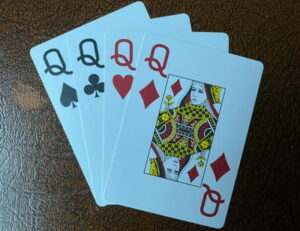 Contrary to what many people may believe, the queen has not always been part of card decks. Further to this, in many European languages, the words for ‘king’ and ‘queen’ start with the same letter. So, the queen is often referred to as the dame (lady). The queen is usually ranked between the king and the jack. In some Spanish and Italian decks, the queen does not exist at all. Instead, a knight is present, offering the same role and value.
Contrary to what many people may believe, the queen has not always been part of card decks. Further to this, in many European languages, the words for ‘king’ and ‘queen’ start with the same letter. So, the queen is often referred to as the dame (lady). The queen is usually ranked between the king and the jack. In some Spanish and Italian decks, the queen does not exist at all. Instead, a knight is present, offering the same role and value.
The queen can be quite the bad card in several games, too. For example, in the game of Hearts, the queen of spades is one to avoid. She is often referred to in a variety of unpleasant names in this game.
When playing cards first came to Europe in the early 1400s, the queen was nowhere in the decks. Face cards came in the form of the king, the knight and the knave. The latter of these is what we refer to today as jacks. It was only in the 1440s that the queens made their first foray into playing cards. This began in Germany and then spread to other nations’ playing cards. She has existed in the cards ever since that time, although as noted, some nations still don’t have her.
As with the king, the Paris pattern puts together identities for each of the queens. They are:
- Queen Pallas of Spades (An epithet of Greek goddess Athena, goddess of wisdom, warfare and handicraft)
- Queen Judith of Hearts (Based on the Book of Judith from Deuteronomy in the Bible)
- Queen Rachel of Diamonds (A Biblical figure and the favourite of Jacob’s two wives)
- Queen Argine of Clubs (An anagram of Regina, the Latin for “queen”)
The Jack Card
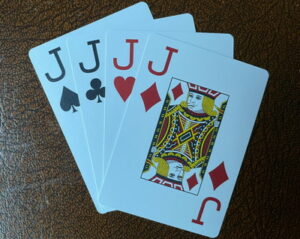 The jack is one of the most intriguing playing cards, often depicting a man in traditional courtier dress. The attire is usually associated with Europe in the 16th or 17th century. Jacks sit between the 10 and the queen and is the lowest court card in a deck. It hasn’t always gone by the name of the Jack, though. Early card decks featured a knave, which has evolved to become the jack card.
The jack is one of the most intriguing playing cards, often depicting a man in traditional courtier dress. The attire is usually associated with Europe in the 16th or 17th century. Jacks sit between the 10 and the queen and is the lowest court card in a deck. It hasn’t always gone by the name of the Jack, though. Early card decks featured a knave, which has evolved to become the jack card.
The earliest predecessor to the knave is the thānī nā’ib in a Mamluk card deck. This represented the second or under-deputy). As is the case with the jack, it was the lowest of all three court cards. Once the Mamluk cards arrived in Italy and Spain, this card became an infantry soldier. That ranked below the knight card (which became the queen later on). In France, players called the card the valet. Once the queen replaced the knight, the format of king-queen-valet arrived in England.
The card went by the name of the knave in England as early as the mid-16th century. That word’s original meaning was ‘boy or young man’. The German equivalent, Knabe, still has this meaning. With regard to a royal household, it refers to a male servant without any specific role. The French word Valet means the same thing. Knave became quite the derogatory word, as royal households would have so many of these young men. They would go around the streets picking fights, molesting girls and causing disturbance.
Jack became a common term in the 16th and 17th centuries. This meant any generic man, as in a Jack-of-all-Trades. Yet it didn’t really become a part of playing card terminology until 1864. At this point, American cardmaker Samuel Hart published a deck with the “J” instead of “Kn”. Games of All Fours had been referring to the knave as the jack since the 17th century. Yet many people considered this to be a low-class usage of the word. The card abbreviation for knave was so close to that for the king that people were easily confused. That confusion grew when the markings for suits and rankings moved to the corners.
The changing of the knave to the jack became entrenched in playing cards. This is despite books of card games published in the later 19th century still using the “knave” term.
The German nickname for the card of Bauer (meaning “farmer” or “peasant”) is also often used for jacks. It appears in English as a loanword, Bower. People use this in top trumps in games of the euchre family.
As with the king and queen, the French pattern attributes historical/mythological figures to the jack cards. They are:
- Ogier the Dane as the Jack of Spades (Legendary paladin of Charlemagne)
- La Hire as the Jack of Hearts (French military commander during the Hundred Years’ War)
- Hector as the Jack of Diamonds (Trojan prince in Greek mythology, and greatest warrior during the Trojan War)
- Lancelot as the Jack of Clubs (Character from Arthurian legend, typically depicted as close companion to King Arthur)
What About the Joker?
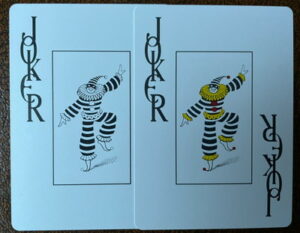 As a final bit of insight, we wanted to highlight the joker card as well. Found in most French-suited card decks, it serves as an addition to the standard four suits. It is the game of Euchre that receives the credit for introducing joker cards. The game did start out without a joker not included. A set of rules from 1868 brings it into play, though. At that time, it was a blank specimen card, not intended for gameplay.
As a final bit of insight, we wanted to highlight the joker card as well. Found in most French-suited card decks, it serves as an addition to the standard four suits. It is the game of Euchre that receives the credit for introducing joker cards. The game did start out without a joker not included. A set of rules from 1868 brings it into play, though. At that time, it was a blank specimen card, not intended for gameplay.
This popularised a variant of the game, entitled “Euchre with the Joker”. The blank card ranked above all others within this version. Yet it must have been in use before that time, as a satirical piece on the American Civil War from 1861 notes it. The cards with the label of “Joker” began appearing in the late 1860s. Some of them depicted clowns and/or jesters.
Jokers do not have a standardised appearance across the card printing industry. Each company creates and prints their own depictions of it. Jokers are often trademarked by companies, with unique artwork reflecting different cultures. Jokers will more often than not appear as jesters, and there are usually two per deck. It is frequent for one to be black and another red, reflecting the card suit colours. If playing a game that compares jokers, then the red one usually outranks the black one.



